



US Feed Outlook - August 2009
In spite of a cool wet spring that delayed plantings, the 2009 corn crop is forecast to be the second largest on record, according to the USDA's Economic Research Service (ERS).US Corn Production Second Highest on Record
This month’s 2009/10 outlook is shaped by the first survey-based forecasts for US corn and sorghum production. In spite of a cool wet spring that delayed plantings, the 2009 corn crop is forecast to be the second largest on record. Sorghum production is forecast down 19 per cent from last year. With larger production, projection for both feed and residual use and ethanol use are increased. US corn export prospects are also increased for 2009/10. Ending stocks for the four feed grains in 2009/10 are projected up from last month but down from 2008/09. Feed grain supplies are expected to be larger than last month, and prices are expected to be weaker. Declines in foreign corn production offset almost half the US increase. Lower corn production prospects in South Africa, Ukraine, and Russia reduce export competition, while lower production in Mexico expands US export market potential.

Domestic Outlook
Feed grain supply up from last year
US feed grain production in 2009 is forecast at 339.6 million metric tons, up 12 million from a month ago and up 13.7 million from 2008. Production from last year is up for corn and oats but down for sorghum and barley. Feed grain supply in 2009/10 is forecast at 390.4 million tons, up 10.5 million from last month and up 16.5 million from 2008/09. Forecast beginning stocks are lowered 1.3 million tons from last month, but are up 3 million tons from the previous year.
Total feed grain use is projected at 345.2 million tons in 2009/10, up 8.7 million from last month and also up 19.4 million from the previous year. The year-to-year increase reflects higher projected exports and a large expected increase in corn use for ethanol. Feed and residual use in 2009/10 is expected to total 141.7 million tons, up 2.3 million from last month but down 0.8 million from 2008/09. Food, seed, and industrial (FSI) use, at 146.1 million tons, is up 2.5 million from last month and up 13.6 million from the previous year. Exports are forecast at 57.3 million tons, up 3.8 million from last month and up 6.5 million from last year. The Bureau of the Census issued revised numbers for 2008, which primarily moved some trade from one month to the next. Imports were unchanged for the year, even with small monthly changes. Market year exports for feed grains in 2008/09 are raised from 49.5 million tons to 50.8 million, as trade revisions were more than offset by the increase in projected 2008/09 corn exports. Ending stocks for 2008/09 are lowered to 48.1 million tons, down from 49.4 million last month.
Feed and residual use for 2009/10 for the four feed grains plus wheat converted to a September-August marketing year is 146.75 million tons, up from 144.35 million last month. This is based on higher projections for corn feed and residual use in 2009/10. Grain-consuming animal units (GCAU) are projected at 90.6 million this month, down slightly from 91.1 million last month. As GCAUs decline and feed and residual use for the four feed grains plus wheat increases, feed and residual use per animal unit is increased to 1.62 tons, up from 1.58 tons last month.
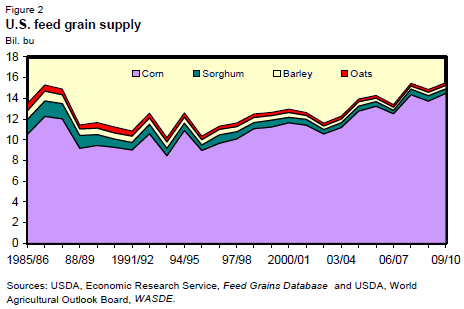
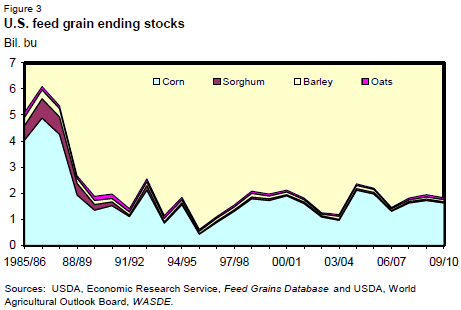
The 1 July Cattle report, which was released on 24 July, indicated lower cow numbers, a smaller calf crop, fewer cattle on feed, and fewer cattle outside feedlots than last year, all implying smaller feedlot placements through the balance of 2009 and into 2010. This also implies lower feedlot marketings and cattle slaughter resulting in lower beef production prospects this month. Poultry production is also lowered this month due to weaker turkey production. Pork production is raised slightly this month, but decreases in beef and poultry production more than offset the pork increase. GCAUs for beef, broilers, and turkeys are down, with dairy up and hogs remaining unchanged this month.
Second Largest Corn Crop Forecast
Corn production is forecast at 12.8 billion bushels, up 471 million bushels from last year but 2 per cent lower than the record in 2007. Harvested acreage is forecast at 80.0 million acres for grain, down 100,000 acres from last month but up 2 per cent from last year. Based on 1 August conditions, yields are expected to average 159.5 bushels per acre, up 6.1 bushels from last month’s trend yield of 153.4 bushels and the actual 2008 yield of 153.9 bushels. If realized, this would be the second highest yield on record, behind 2004, and production would be the second largest, behind 2007. The 1 August corn objective yield data indicate a record high number of ears per acre for the combined 10 objective yield States (Illinois, Indiana, Iowa, Kansas, Minnesota, Missouri, Nebraska, Ohio, South Dakota, and Wisconsin). Record high ear counts are forecast in all objective yield States except Illinois, Missouri, and Wisconsin. As of 2 August, 68 per cent of the crop was rated in good to excellent condition in the 18 major corn-producing States, up 2 per centage points from a year ago.


Total use for corn is forecast up 350 million bushels to 12.875 billion bushels this month as a result of increased demand. FSI use is increased 100 million bushels to 5.475 billion in 2009/10. This reflects the 100-million-bushel increase in ethanol usage, which is supported by favorable ethanol producer returns and strong incentives for ethanol blending. All other FSI categories remain unchanged this month. As foreign production prospects are reduced this month, US exports for 2009/10 are increased 150 million bushels to 2.1 billion this month. There is also increased import demand originating from Mexico and Taiwan. Increases in production are only partially offset by the increases in total use for corn; ending stocks are raised 71 million bushel this month to 1.621 billion bushels for 2009/10. For the 2008/09 marketing year, exports are raised 50 million bushels to 1.85 billion, reflecting shipments to-date. This lowers 2009/10 beginning stocks to 1.72 billion bushels, but supplies rise as sharply higher forecast production is more than offsetting.
US Bureau of Census trade revisions included trade changes for calendar year 2008. In the 2007/08 marketing year, exports are raised 2 million bushels to 2.437 billion bushels. FSI use is raised by 24 million bushels to 4.387 billion because of a revision in ethanol production by the Energy Information Administration. Together, these revisions result in lower feed and residual use, down 25 million bushels to 5.913 billion.
Corn prices received by farmers for 2009/10 are forecast at $3.10-$3.90 per bushel, down 25 cents on both ends of the range this month. The marketing year average reflects higher prices for corn sold for forward delivery over the past several months ahead of the sharp downturn in futures and cash markets since early June.
2009 sorghum supply increases slightly
Sorghum production is forecast at 381 million bushels, up 1 million from last month but down 19 percent from last year. Expected area for harvest as grain is forecast at 5.9 million acres, down from 6.0 million last month and down 18 percent from 2008. Based on 1 August conditions, yield is forecast at 64.0 bushels per acre, down 1.0 bushel from last year. In Kansas, the top producing State, yields are expected to increase by 1.0 bushel from last year, while in Texas, the second leading State in sorghum production, yields are expected to decrease 5 bushels per acre. As of 2 August, 50 per cent of the sorghum crop was rated good to excellent, equal to the ratings a year earlier.
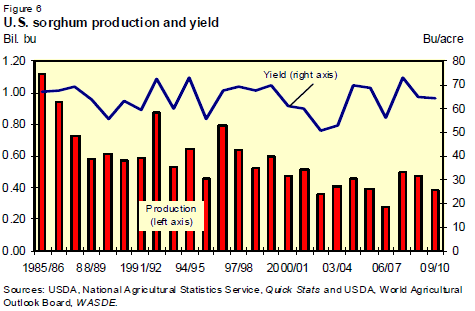
Total use for sorghum in 2009/10 is forecast at 380 million bushels, which remains unchanged this month. The increase in production results in a 1-million-bushel increase in ending stocks to 51 million.
The US Bureau of Census has released trade revisions for calendar year 2008. A very small increase to sorghum imports and a 1-million-bushel reduction in exports raises feed and residual 1 million bushels to 165 million. There were no trade revisions that affected the 2008/09 marketing year for sorghum.
Sorghum prices received by farmers for 2009/10 are expected to average $2.70- $3.30 per bushel, compared with $2.85 to $3.55 last month, as large corn supplies lower demand and prices for sorghum. The 2008/09 sorghum price is narrowed 5 cents on both ends of the range to $3.15-$3.25 per bushel.
Barley production to increase in 2009
Barley production for 2009 is forecast at 207 million bushels, up 4 million bushels from last month but down 14 per cent from 2008. Based on August 1 conditions, producers expect yields to average 65.8 bushels per acre, up 1.1 bushels from last month and 2.2 bushels from a year ago. Area harvested remains unchanged at 3.1 million acres, down 17 per cent from 2008. On August 2, 78 per cent of this year’s crop was rated in good to excellent condition, compared with 53 per cent a year ago.
Total barley supplies in 2009/10 were raised 3 million bushels this month to 325 million, as a result of increased production. Total domestic use is forecast at 230 million bushels, unchanged this month as both feed and residual use and FSI remain unchanged this month. Exports also are unchanged this month at 15 million bushels for 2009/10. With higher production and no changes to barley use this month, ending stocks are projected up 3 million bushels to 80 million, which is down from 89 million in 2008/09.
US Bureau of Census revisions for calendar year 2008 lower barley imports 3 million bushels for marketing year 2007/08, resulting in a 3-million-bushel decrease in total supply. Feed and residual use is lowered by 2 million bushels. Minor changes were also made to the 2008/09 marketing year, with a small increase to imports and a corresponding increase in feed and residual use.
Prices received by farmers for barley in 2009/10 are expected to average $3.70- $4.40 per bushel, compared with $3.65-$4.35 per bushel last month.
Oats supply prospects lowered
Oats production for 2009 is forecast at 92 million bushes, increased slightly from a month ago and up 3 million from 2008. If realized, this would be the third lowest production on record. Harvested area is forecast at 1.43 million acres, unchanged from last month and just above last year’s record low. Based on 1 August conditions, producers expect yields to average 64.5 bushels per acre, an increase of 0.5 bushels from the July forecast and up 1.0 bushels from last year. On 2 August, 56 per cent of the oat crop in the nine major producing States was rated as good to excellent, compared with 57 per cent last year.
Total oats supplies are lowered 14 million bushels this month to 271 million, reflecting a reduced import forecast as the Canadian oats crop is lowered. Oats feed and residual use in 2009/10 is projected 10 million bushels lower this month, due to the lower supplies. FSI use is unchanged at 75 million bushels. Exports also are unchanged. With lower expected imports and the 1-million-bushel increase in production, ending stocks are projected 4 million bushels lower than last month at 73 million bushels. This is also down from 84 million bushels in 2008/09.
US Bureau of Census revisions for calendar year 2008 result in minor changes in oats imports for marketing year 2007/08 and a corresponding increase in feed and residual use.
Prices received by farmers in 2009/10 are expected to average $1.90-$2.50 per bushels, compared with $1.95-$2.75 per bushel expected last month.
Hay production to increase
All hay production in 2009 is forecast at 152 million tons, up 6.27 million from 2008 due to higher harvested acres and yields. The all-hay yield is expected to be 2.52 tons per acre, up from 2.43 tons per acre in 2008. Harvested acres are forecast at 60.2 million acres, up slightly from 60.1 million last year.
Alfalfa hay production is forecast at 73.0 million tons, up 5 percent from last year. Yields are expected to average 3.48 tons per acre, slightly higher than the 3.32 tons last year. Harvested area is forecast at 21.0 million acres, unchanged from June but down 2,000 acres from the previous year.
Other hay production is forecast at 79.0 million tons, up 4 percent from last year. Based on 1 August conditions, yields are expected to average 2.01 tons per acre, up 0.06 tons from last year. Harvested area, at 39.2 million acres, is unchanged from June but up 113,000 acres from the previous year.
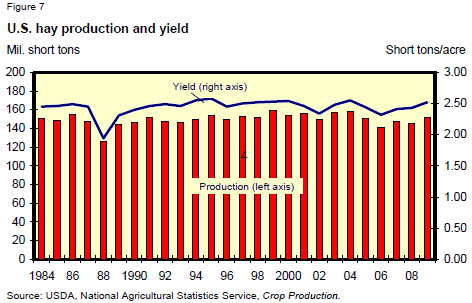
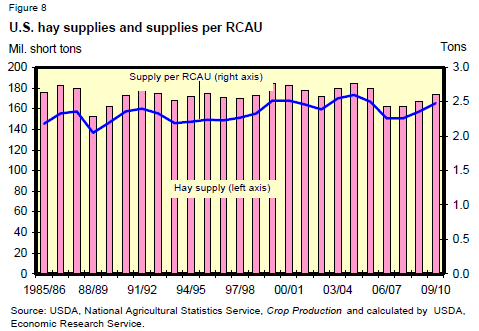
Roughage-consuming animal units (RCAUs) in 2009/10 are estimated to be down slightly from 2008/09. With hay production up and RACUs down, hay supply per RCAU is 2.48 tons, compared with 2.36 tons in 2008/09.
The average price received by farmers for the first 3 months of the 2009/10 marketing year (May-July) forall hay was $123.33 per ton, compared to $164.33 during the same time period in 2008/09. The alfalfa hay price for the first 3 months in 2009/10 marketing year was $128.66 per ton, compared with $176.33 in 2008/09. The average price received by farmers for hay other than alfalfa and alfalfa mixtures for the first 3 months in 2009/10 was $108.00 per ton, down from $131.66 in 2008/09. With plentiful supplies and lower input costs as compared to last year, farmers should expect lower prices for hay in 2009/10 in comparison to 2008/09.
International Outlook
Reduced foreign corn production offsets part of the US increase
World coarse grain production in 2009/10 is projected to reach 1,091.6 million tons, up 8.2 million tons, as a large increase in US corn production is partly offset by a 5.5-million-ton reduction in forecast foreign corn output.
Eastern Ukraine and the Southern District of Russia suffered hot dry weather during July that damaged reproductive corn in the region. Area harvested for grain and projected yield are reduced for both countries, cutting corn production in Russia 1.5 million tons to 5.0 million and trimming corn output in Ukraine 1.0 million tons to 8.5 million.
In Mexico, rainfall so far has been below normal, especially across the Central Plateau, and temperatures have been above normal, hurting the development of corn. A strengthening El Nino in the Pacific is associated with continuing dry conditions across the key central corn region. The yield forecast for Mexico’s corn is reduced from trend to the 5-year average, cutting projected production 1.5 million tons this month to 22.5 million.
In South Africa, the prospect of El Nino-generated dryness is contributing to a lack of producer enthusiasm for planting corn. Corn area is cut 13 per cent this month, reducing production prospects 1.0 million tons to 10.5 million.
Dry, hot weather during reproduction hurt corn yield potential in Serbia, cutting production 0.5 million tons to 6.0 million. In the EU, heat and drought in Spain cut corn production potential, more than offsetting improved prospects in countries with good rainfall, like Germany. EU corn production is down 0.25 million tons to 56.2 million.
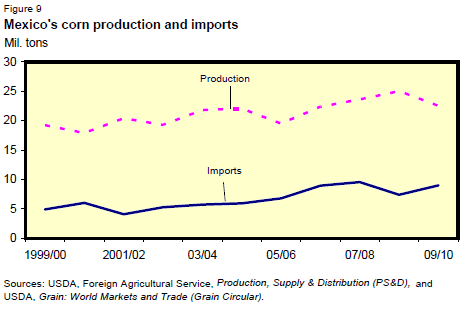
This month the only non-US increase in corn production prospects was for El Salvador, up 0.3 million tons to 0.9 million as the historical series for area and yield was revised.
Foreign sorghum production increased 0.75 million tons to 52.8 million. The uneven, weak monsoon in India is causing some producers to switch area from rice to sorghum. Sorghum production is projected up 0.5 million tons this month to 8.0 million. Sorghum area in Uruguay is reported to have declined less than previously forecast, boosting production prospects 0.2 million tons to 0.4 million. Sorghum production in El Salvador increased slightly.
Foreign barley production increased 0.5 million tons this month to 138.2 million. The largest increase this month is for Ukraine, up 1.8 million tons to 11.5 million. Harvest reports indicate higher area and yield than expected. China reported increased barley area, boosting production 0.3 million tons, and there were smaller increases for Australia, Kyrgyzstan, and Afghanistan. These increases were partly offset by reductions in some countries. Barley production prospects for Turkey are cut 0.75 million tons to 6.0 million due to lower reported yields. Projected barley production in Canada is reduced 0.6 million tons to 8.8 million, as drought in Alberta has reduced harvested area prospects. EU barley production prospects are trimmed 0.3 million tons this month as a sharp reduction in yields in Spain is partly offset by increased prospects across Northern Europe, where rains were favorable. Kazakhstan had a small decline in yield prospects.
Foreign rye production is increased 0.4 million tons to 16.4 million as favorable growing conditions across Northern Europe boosted EU prospects. There are also small increases for Ukraine and Canada. Foreign mixed grains increased 0.4 million tons to 15.1 million due to increased EU prospects across France, Germany, and Poland.
Foreign oats production is down 0.5 million tons this month to 21.8 million mostly due to a 0.8-million-ton drop in prospects for Canada to only 2.65 million tons. There is a small increase this month for Ukraine and the EU.
Changes to 2009/10 beginning stocks caused by revisions to 2008/09 coarse grain supply and demand were mostly offsetting and did not affect global supplies. However, some countries did change significantly. Canada’s coarse grain stocks are reduced 1.3 million tons to 4.6 million as increased feed use of barley and corn in 2008/09 cut stocks. For Brazil’s corn, increased 2008/09 production, larger imports, and reduced food use boosted stocks 1.3 million tons. Reduced domestic use of barley and corn boosted Ukraine’s 2009/10 coarse grain beginning stocks 0.85 million tons. Increased 2008/09 corn imports boosted 2009/10 beginning stocks 0.4 million tons each for Iran and Egypt. There are several smaller changes as well.
Consumption Prospects Increase
Global coarse grain use for 2009/10 is projected up 5.8 million tons this month to 1,096.9 million. Most of the increase is for U.S. corn, but foreign coarse grain use is forecast up 0.9 million tons to 808.7 million tons. The largest foreign increase in use is for Australia, up 0.6 million tons, due to increased feed use prospects. China’s coarse grain use is up 0.5 million tons this month, mostly because of strong demand for malting barley (beer). India’s consumption is up 0.5 million tons, with more sorghum being grown and used for food. Smaller increases are projected this month for the EU, Taiwan, El Salvador, Iran, Uruguay, Sudan, Ukraine and Afghanistan. A larger increase in global marketing year exports than in imports also boosts disappearance adding to the global consumption projection.
Reduced corn production is contributing to a 1.5-million-ton reduction in coarse grain consumption in Russia. Reduced supplies in Canada are cutting projected use 1.0 million tons, with feed prospects slashed. In Brazil, less corn is projected to be used for food, reducing use 0.5 million tons. Smaller reductions in 2009/10 use are projected this month for South Africa and Chile.
World Ending Stocks Up This Month
Global ending stocks of coarse grain in 2009/10 are increased 2.5 million tons to 181.5 million. Most of the increase is in the United States, but foreign stocks are forecast up 0.7 million tons to 136.2 million.
Brazil’s corn stocks are projected up 1.8 million tons to 10.9 million as increased beginning stocks combine with reduced food use. Increased barley production is boosting Ukraine’s coarse grain ending stocks prospects 0.8 million tons. For Egypt, increased beginning stocks of corn are boosting ending stocks 0.4 million tons. Smaller increases are forecast this month for Russia, Iran, the EU, China, El Salvador, Argentina, and Uruguay.
Reduced coarse grain ending stocks are projected this month for Canada, down 1.1 million tons due to reduced supplies of barley and oats; for Turkey, cut 0.7 million tons because of reduced barley production; are for Serbia, down 0.5 million tons due to trimmed corn production smaller reductions are projected for South Africa, Paraguay, Sudan, Chile, Australia, and Cuba.
Increased World Corn Trade Boosts US Export Prospects
Global corn trade in 2009/10 (October-September trade year) is projected to reach 84.5 million tons, up 2.75 million this month. Corn imports by Mexico are up 1.5 million tons to 9.0 million because of reduced production prospects. Taiwan’s corn imports are raised 0.3 million tons to 4.6 million as strong imports during 2008/09 reveal a higher level of feed demand than previously expected. "Unaccounted imports" were also raised this month. However, corn imports forecast for El Salvador were trimmed 0.1 million tons as the revised production series limits import needs.
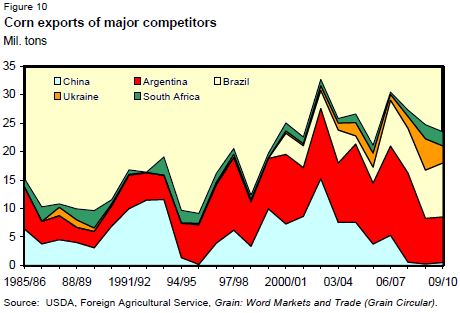
Prospects for competition from other corn exports shifted slightly this month. With reduced production in Ukraine and Russia, export prospects there are reduced by 0.5 and 0.3 million tons, respectively. However, exports for South Africa increased 0.5 million tons to 2.5 million. Even with 2009/10 production prospects reduced this month, South Africa is expected to ship more old-crop corn during the October- September 2009/10 trade year and more new-crop corn sooner in its May-April 2009/10 local marketing year than was the case in 2008/09.
US corn exports are projected to reach 53.0 million tons in 2009/10 (2.1 billion bushels for the September-August local marketing year), up 3.0 million tons this month as supplies are abundant and US prices are expected to be competitive. Carryover sales from the previous marketing year are also expected to be up in 2009/10.
US corn exports for 2008/09 are up 1.5 million tons this month to 47.0 million (1.85 billion bushels for the local marketing year). The pace of recent sales and shipments has been strong, with July Export Inspections surpassing 5 million tons. Corn export shipments in August and September are expected to slow from July’s torrid pace.
World corn trade for 2008/09 is up 1.8 million tons this month to 80.7 million, as reported data confirm higher trade levels. Imports are raised for Egypt, Iran, and Brazil, but reduced for Chile. Corn exports for Argentina are up 1.0 million tons, and Paraguay is up 0.5 million, but Brazil is cut 1.0 million, all based on the pace of recent sales and shipments.
Global barley trade for 2009/10 (October-September) is increased to 17.6 million tons due to a 0.3-million-ton increase in China’s malting barley imports to 1.5 million. Ukraine is expected to be much more competitive in the barley market, with exports projected up 1.5 million tons to 6.0 million, but export prospects are reduced for Australia, Canada, and the EU.
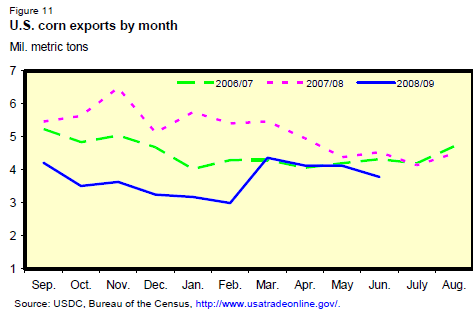
Further Reading
| - | You can view the full report by clicking here. |
August 2009








